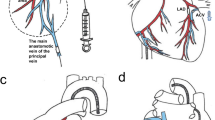Abstract
Delivery of viral vectors to the heart represents a challenging endeavor. Besides vector design, the route of substrate administration is significantly influencing gene delivery success. The selective retrograde venous injection (SRVI) represents one of the most efficient percutaneous delivery strategies for transduction of the anterior left ventricular myocardium. In this chapter, we discuss the advantages and limitations of this vector delivery approach and provide a protocol for selective retrograde venous injection in a preclinical large animal model. As limited transgene expression frequently hampers generation of reliable proof-of-principle data and thus translation, this technique provides a valuable tool to ensure high myocardial transduction in preclinical research.
Access this chapter
Tax calculation will be finalised at checkout
Purchases are for personal use only
Similar content being viewed by others
References
Pleger ST, Shan C, Ksienzyk J, Bekeredjian R, Boekstegers P, Hinkel R, Schinkel S, Leuchs B, Ludwig J, Qiu G, Weber C, Raake P, Koch WJ, Katus HA, Muller OJ, Most P (2011) Cardiac AAV9-S100A1 gene therapy rescues post-ischemic heart failure in a preclinical large animal model. Sci Transl Med 3(92):92ra64. https://doi.org/10.1126/scitranslmed.3002097
Raake PW, Schlegel P, Ksienzyk J, Reinkober J, Barthelmes J, Schinkel S, Pleger S, Mier W, Haberkorn U, Koch WJ, Katus HA, Most P, Muller OJ (2013) AAV6.betaARKct cardiac gene therapy ameliorates cardiac function and normalizes the catecholaminergic axis in a clinically relevant large animal heart failure model. Eur Heart J 34(19):1437–1447. https://doi.org/10.1093/eurheartj/ehr447
Katz MG, Fargnoli AS, Pritchette LA, Bridges CR (2012) Gene delivery technologies for cardiac applications. Gene Ther 19(6):659–669. https://doi.org/10.1038/gt.2012.11
Fearon WF, Ikeno F, Bailey LR, Hiatt BL, Herity NA, Carter AJ, Fitzgerald PJ, Rezaee M, Yeung AC, Yock PG (2004) Evaluation of high-pressure retrograde coronary venous delivery of FGF-2 protein. Catheter Cardiovasc Interv 61(3):422–428. https://doi.org/10.1002/ccd.10790
Boekstegers P, von Degenfeld G, Giehrl W, Heinrich D, Hullin R, Kupatt C, Steinbeck G, Baretton G, Middeler G, Katus H, Franz WM (2000) Myocardial gene transfer by selective pressure-regulated retroinfusion of coronary veins. Gene Ther 7(3):232–240. https://doi.org/10.1038/sj.gt.3301079
Sasano T, Kikuchi K, McDonald AD, Lai S, Donahue JK (2007) Targeted high-efficiency, homogeneous myocardial gene transfer. J Mol Cell Cardiol 42(5):954–961. https://doi.org/10.1016/j.yjmcc.2007.02.004
Logeart D, Hatem SN, Heimburger M, Le Roux A, Michel JB, Mercadier JJ (2001) How to optimize in vivo gene transfer to cardiac myocytes: mechanical or pharmacological procedures? Hum Gene Ther 12(13):1601–1610. https://doi.org/10.1089/10430340152528101
Raake P, von Degenfeld G, Hinkel R, Vachenauer R, Sandner T, Beller S, Andrees M, Kupatt C, Schuler G, Boekstegers P (2004) Myocardial gene transfer by selective pressure-regulated retroinfusion of coronary veins: comparison with surgical and percutaneous intramyocardial gene delivery. J Am Coll Cardiol 44(5):1124–1129. https://doi.org/10.1016/j.jacc.2004.05.074
Karakikes I, Hadri L, Rapti K, Ladage D, Ishikawa K, Tilemann L, Yi GH, Morel C, Gwathmey JK, Zsebo K, Weber T, Kawase Y, Hajjar RJ (2012) Concomitant intravenous nitroglycerin with intracoronary delivery of AAV1.SERCA2a enhances gene transfer in porcine hearts. Mol Therap 20(3):565–571. https://doi.org/10.1038/mt.2011.268
Acknowledgments
This work is supported by grants from the Deutsche Forschungsgemeinschaft (RA 1668/1-1 and RA 1668/3-1) to P.W.R.
Author information
Authors and Affiliations
Corresponding author
Editor information
Editors and Affiliations
Rights and permissions
Copyright information
© 2022 The Author(s), under exclusive license to Springer Science+Business Media, LLC, part of Springer Nature
About this protocol
Cite this protocol
Schlegel, P., Raake, P.W.J. (2022). Cardiac Gene Delivery in Large Animal Models: Selective Retrograde Venous Injection. In: Ishikawa, K. (eds) Cardiac Gene Therapy. Methods in Molecular Biology, vol 2573. Humana, New York, NY. https://doi.org/10.1007/978-1-0716-2707-5_13
Download citation
DOI: https://doi.org/10.1007/978-1-0716-2707-5_13
Published:
Publisher Name: Humana, New York, NY
Print ISBN: 978-1-0716-2706-8
Online ISBN: 978-1-0716-2707-5
eBook Packages: Springer Protocols



